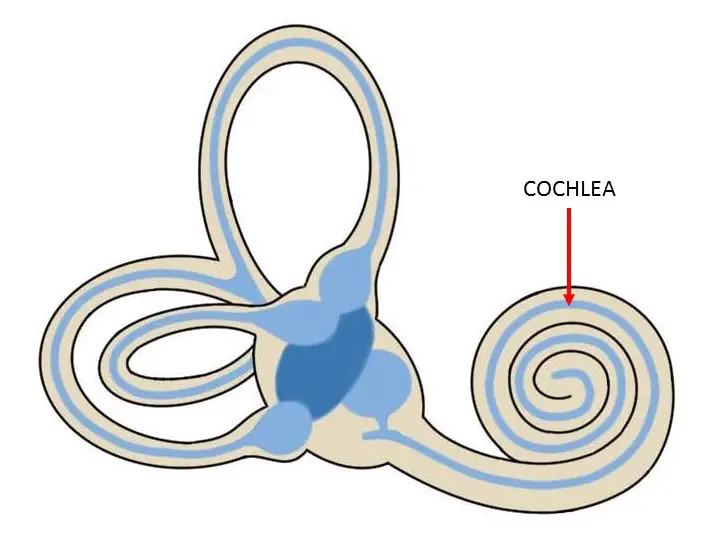Know Your Brain: Cochlea
Where is the cochlea?

The cochlea is a coiled structure that resembles a snail shell (cochlea comes from the Greek kochlos, which means "snail"); it is found within the inner ear. It is a small--yet complex--structure (about the size of a pea) that consists of three canals that run parallel to one another: the scala vestibuli, scala media, and scala tympani.
What is the cochlea and what does it do?
When sound waves travel through the canal of our outer ear, they hit the tympanic membrane (aka eardrum) and cause it to vibrate. This vibration prompts movement in the ossicles, a trio of tiny bones that transmit the vibration to a structure called the oval window, which sits in the wall of the cochlea. The ossicle bone known as the stapes taps on the oval window to pass the vibration on to the cochlea, all the while using a fine-tuned movement that preserves the frequency of the original sound wave that hit the eardrum.
The cochlea is filled with fluid. Specifically, the scala vestibuli and scala tympani contain a fluid called perilymph, which is similar in composition to cerebrospinal fluid, and the scala media contains endolymph, which more resembles intracellular fluid in terms of its ionic concentrations. When the oval window is depressed by the stapes it creates waves that travel through the fluid of the cochlea, and these waves cause a structure called the basilar membrane to move as well.
The basilar membrane separates the scala tympani from the scala media. When waves flow through the fluid in the cochlea, they create small ripples that travel down the basilar membrane itself (to visualize these ripples imagine the basilar membrane as a rug someone is shaking out). The basilar membrane is structured such that different sections of the membrane respond preferentially to different frequencies of sound. As waves progress down the basilar membrane, they reach their peak and then rapidly diminish in amplitude at the part of the membrane that responds to the frequency of the sound wave created by the original stimulus. In this way, the basilar membrane accurately translates the frequency of sounds picked up by the ear into representative neural activity that can be sent to the brain.
The translation of the movement of the basilar membrane into electrical impulses occurs in the organ of Corti, which is the receptor organ of the ear. It sits atop the basilar membrane and contains around 16,000 receptor cells known as hair cells. Hair cells are so named because protruding from the top of each cell is a collection of somewhere between 50 and 200 small "hairs" called stereocilia. Hair cell stereocilia have fine fibers, known as tip links, that run between their tips; tip links are also attached to ion channels. When the basilar membrane vibrates, this induces movement of the hair cells, which causes the tip links to pull open the associated ion channels for a fraction of a millisecond. This is long enough to allow ions to rush through the ion channels to cause depolarization of the hair cell. Depolarization of hair cells leads to a release of neurotransmitters and the propagation of the auditory signal. The vestibulocochlear nerve will carry the information regarding the auditory stimulus to the brain, where it will be analyzed and consciously perceived.
Reference:
Moller, A. (1994). Auditory Neurophysiology Journal of Clinical Neurophysiology, 11 (3), 284-308.


